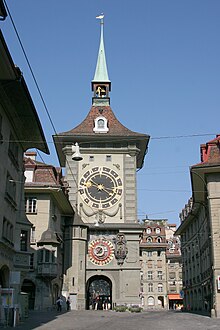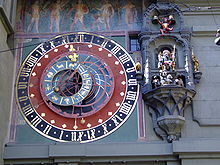Zytglogge



The Zytglogge ("time bell"; Bern German pronunciation [ˈtsi (t) ˌklɔkə] ; also clock tower ) is a medieval clock tower with a well-known astronomical clock and carillon in the city of Bern , Switzerland .
history
The fortified tower, which has been extended several times, was built between 1218 and 1220 as the western end of the main street of the city of Bern, founded in 1191 . With each expansion of the city, which could only take place to the west due to the location of the old town in the Aare loop , the tower moved more towards the city center, lost its function as a defensive tower and was then used differently. Before the big fire in 1405 , it served as a prison. He then became a clock tower - Zytgloggeturm or short Zytglogge from - Bernese sandstone rebuilt. His tower clock with striking mechanism indicated the binding time for the entire city. The hours of travel were measured from the tower .
In the 16th century, the cuboid tower was given its towering shape and a new clock. The edicts and ordinances are posted in the gate passage and since the 18th century the length measurements have been attached for public control. With the late baroque renovations of 1770/71 it was completely integrated into its surroundings.
Tower clocks, striking mechanisms and figure games
The Zytglogge houses one of the oldest tower clocks in Switzerland. Its clockwork consists of five combined movements housed in a common housing: the movement , two striking mechanisms and two movements for figure games. The hands above the two large upper 12-hour dials and the astrolabe clock are driven from the hour axis of the movement .
One of the two striking mechanisms sets the hour strike in the tower top in motion. The other causes the quarter-hour strikes, which also occur in the top of the tower.
The figure games are located in the players' dungeon under the large east 12-hour display to the right of the astrolabe clock.
The basic features of the astrolabe clock come from the years 1405/06. The sky and horizon are shown in stereographic projection from the north pole of the sky. The geocentric view of the world still applies , according to which the stars orbit the earth. The rotating parts depict the daily apparent rotation of the stars, the sun and the moon.
A sun symbol is attached to a large pointer, the outer end of which shows the time of day with one hand over the outer 2 x 12 hour scale. The symbol shows the daily course of the sun between rise and set above the horizon. It also slides on the eccentric ring that represents the ecliptic circle scaled with the zodiac signs . This ring rotates a little faster every day (one revolution in a sidereal day , equal to about 23 hours and 56 minutes) than the sun / hour hand around the center of the watch. Because of this small difference, the sun symbol slides around the zodiac once a year. With the current position of the sun in the zodiac, the year date is roughly displayed. Together with the eccentric zodiac ring rotates this comprehensive centric ring, on the scale of which the sun / hour hand shows the month and day of the month exactly. Since the sun symbol is also shifted radially on the sun / hour hand, it moves on a high day arc in summer and a low one in winter. The eccentric zodiac pushes it all the way out at the point with the greatest distance from the clock axis (zodiac signs Gemini and Cancer ). In winter ( Sagittarius and Capricorn zodiac signs ) it is all the way inside. The two-dimensionally moving sun symbol also shows the current temporal hours of the year, which are unevenly long, above the part of the dial below .
There is a moon ball on another centric pointer. This pointer stays behind the sun pointer for about 48 minutes every day, which means that it hits the sun again after about 29½ days. The moon ball rotates around its pointer rod so that it shows the observer its dark half when it meets the sun ( new moon ). If both symbols are in opposition to each other ( full moon ), the golden half of the moon ball is in view. The lunar sphere is also shifted on its pointer with the help of the ecliptic circle, which simulates the high lunar orbit in winter and the deep lunar orbit in summer. At the top of the astrolabic displays the name of the day of the week appears in a window. The reduction gear from the central hour axis is located behind it inside the tower. The two gears for driving the zodiac and the moon hand are located on the outside of the sun / hour hand, which is driven by the central hour axis. Each is based on a pinion , which is prevented from rotating with the sun pointer by an eccentrically attached weight. The pinions rotate as planet gears . Since they are not turning, they each make a revolutionary movement .
Barely four minutes before the hour, a rooster crows and a fool sitting in a niche rings two bells hanging above him, and then a procession of armed bears moves out of the tower and disappears into it again. Then the rooster crows a second time and lifts its wings. The bearded Chronos , god of time, turns an hourglass, raises his scepter to command the strike of the hour and counts the strokes that the gilded knight in the tower helmet, known as Hans von Thann , strikes with a hammer on the big bell while being a standing lion Head turns as if listening. As soon as the hour bell has stopped, the rooster crows for the third time and announces the beginning of the new hour.
Today's clockwork and chimes date from 1530 and were created by Kaspar Brunner , a Swiss blacksmith of presumably German origin. The original regulator with Balkenwaag ( Foliot ) was later only about 150 years a pendulum - inhibition replaced.
Trivia
A special feature is the public urinal (Vespasienne), which is located on the north side of the tower.
In 1960 the Swiss Post published the series Postal History and Architectural Monuments ; the motif of the 60 centimes stamp is the zytglogge. The stamp was reissued in 1967 with the same motif on purple-fiber paper.
literature
- Ueli Bellwald: The Zytglogge in Bern (= Swiss Art Guide No. 341). Ed. Society for Swiss Art History GSK. Bern 1983, ISBN 3-85782-341-0 .
- Jakob Messerli : The Zytgloggenturm - public wheel clocks in Bern in the 15th century. bmv / Stämpfli, Bern 1999, ISBN 3-906721-28-0 .
- Markus Marti: 600 years of Zytglogge Bern - A small chronicle of time measurement. Stämpfli, Bern 2005, ISBN 3-7272-1180-6 .
- Die Kunstdenkmäler des Kantons Bern , Stadt Bern, Vol. 1, Basel 1952, pp. 107–127. ( Digitized version )
Web links
- Clock tower in German and English, virtual tour and texts by Markus Marti (clock judge)
- Zytglogge Bern 3D tour, texts by Markus Marti (time bell judge)
- Information, pictures, videos and 360 panoramas of the clock tower (Zytglogge) - Bern Tourismus website
- Daily video / audio time lapse from the clock tower
- Contribution & picture of the BZ to the hour hammer "Hans von Thann"
Individual evidence
- ↑ a b www.zeitgloggenturm.ch: From the defense tower to the clock tower
- ↑ www.zeitgloggenturm.ch: The monumental clockwork by Kaspar Brunner
Coordinates: 46 ° 56 ′ 53 " N , 7 ° 26 ′ 52" E ; CH1903: 600 696 / 199664


